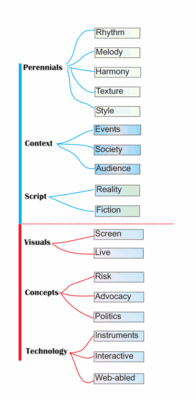 Composer/keyboardist/producer Elodie Lauten creates operas, music for dance and theatre, orchestral, chamber and instrumental music. Not a household name, she is however widely recognized by historians as a leading figure of post-minimalism and a force on the new music scene, with 20 releases on a number of labels.
Composer/keyboardist/producer Elodie Lauten creates operas, music for dance and theatre, orchestral, chamber and instrumental music. Not a household name, she is however widely recognized by historians as a leading figure of post-minimalism and a force on the new music scene, with 20 releases on a number of labels.
Her opera Waking in New York, Portrait of Allen Ginsberg was presented by the New York City Opera (2004 VOX and Friends) in May 2004, after being released on 4Tay, following three well-received productions. OrfReo, a new opera for Baroque ensemble was premiered at Merkin Hall by the Queen's Chamber Band, whose New Music Alive CD (released on Capstone in 2004) includes Lauten's The Architect. The Orfreo CD was released in December 2004 on Studio 21. In September 2004 Lauten was composer-in-residence at Hope College, MI. Lauten's Symphony 2001, was premiered in February 2003 by the SEM Orchestra in New York. In 1999, Lauten's Deus ex Machina Cycle for voices and Baroque ensemble (4Tay) received strong critical acclaim in the US and Europe. Lauten's Variations On The Orange Cycle (Lovely Music, 1998) was included in Chamber Music America's list of 100 best works of the 20th century.
Born in Paris, France, she was classically trained as a pianist since age 7. She received a Master's in composition from New York University where she studied Western composition with Dinu Ghezzo and Indian classical music with Ahkmal Parwez. Daughter of jazz pianist/drummer Errol Parker, she is also a fluent improviser. She became an American citizen in 1984 and has lived in New York since the early seventies
|
|
|
|
|

Sunday, October 02, 2005
Music in the 21st Century

I was in the process of thinking through a new piece, and this is what I came up with - a lot of aspects to consider. It seems that composing entails more than one would think at first. In red are the elements that currently are more in focus - or have become part of the process because of new technologies.
Are we really in the 21st century yet? Some continue to write string quartets and symphonies like Brahms and Mahler, with the same instruments. But there are new elements in the composition process that didn’t exist before. The perennials are rhythm, melody, harmony, texture and style; however, defining style is much more complex. Before the 20th century everyone wrote in the same style. Now we are dealing with multiple stylistic elements, some from classical Western music, some from so-called modern Western music, including the old ‘avant-garde’ – which is actually 20th century music, as opposed to 21st century music; some from ethnic and folk traditions from all over the world; some from popular music, rock and jazz. This should be it, but it really isn’t.
Our society is visually oriented. The proliferation of vision-enhancing devices and laser eye surgery afford people clear vision. We are constantly looking at screens: at work on the computer, at play watching television, films and DVDs. People have become much more sensitive to visual stimuli and they crave them. This poses a problem for the composer: should a piece have a visual content? Does the decline of classical music have anything to do with the fact that the visuals are lacking? Who wants to sit and watch 50 people dressed in black sitting practically still reading music for two hours? Isn’t it better to listen to the piece on a hi-fi? Meanwhile, opera is still popular because it is a show.
Composing in the 21st century also entails balancing a number of other elements: scripts – even for instrumental music, it is easier to get a new piece across if you have a story to tell about it, even if it isn’t program music. The context element actually has always existed; it may even have been stronger in the past when most pieces were written on demand for a special occasion, when music had stronger ties to the social fabric. But now, it seems even more important to compose in context, as a composition addresses many levels of consciousness, and if we are to compose responsibly, social elements have to be taken into account.
In addition, we now have the option of making use of new technology: electronics, hyper-instruments enhanced with additional capabilities and most recently, interactivity through the web. Right now, only a few pioneers are working with these forms, and some of them were gathered at the IAMIC panel on music and technology moderated by Frank Oteri, that took place on September 27 at the Thalia Nimoy. Bill Duckworth and Nora Farrell do everything on and for the web. Tod Machover designs hyper-instruments for children to play. His hyperscore software enables anyone to ‘draw’ a piece on the computer, and the program translates the visual data into music. Every teenager gets to be a rock star on screen, with no practice time. This is the way of the future: instruments that require no practice; you can play them along with someone else in Hong Kong in an interactive jam session.
The web killed the music industry but it may save music-making eventually by making it accessible to each and everyone, no longer restricted to elite of highly trained practitioners. Check out Music: How the Web Got Wired for Sound (Routledge 2005) by William Duckworth, whose site is actually hard to find – don’t look under William Duckworth or Bill Duckworth, but go to www.monroestreet.com; on cathedral on you can participate in a collective composition project on the web. Also, check out www.hyperscore.com, Tod Machover’s visual music creation tool. Also visit www.lemurbots.org for some surprising interactive instruments.
posted by Elodie Lauten
3:12 PM
| |



